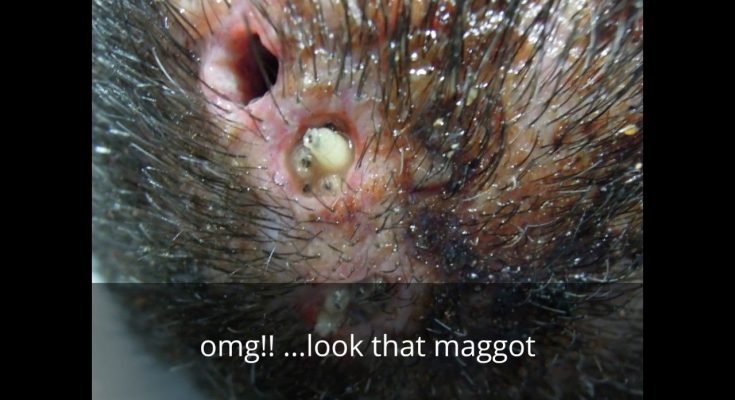Symptoms and Diagnosis
Recognizing Symptoms
Mango worms can cause a range of symptoms in infected animals. The most common symptom is the appearance of raised bumps or lesions on the skin. These bumps may be accompanied by redness, swelling, and discomfort. Infected animals may also experience itching and pain around the affected area.
In some cases, mango worm infections can lead to the formation of boils or open wounds. These wounds may become infected, which can cause additional symptoms such as fever and general malaise.
Diagnostic Procedures
Diagnosing a mango worm infection typically involves a physical examination of the animal. The veterinarian may look for signs of skin lesions, bumps, or other abnormalities on the skin. They may also ask about the animal’s symptoms and medical history.
In some cases, the veterinarian may need to take a sample of the infected tissue for further analysis. It may involve a biopsy or the collection of skin scraping. These samples can be examined under a microscope to confirm the presence of mango worm larvae.
Overall, early diagnosis and treatment of mango worm infections is significant to prevent complications and ensure a full recovery.
Treatment and Removal
Medical Treatment
In most cases, medical treatment is necessary to treat mango worm infestation. Antibiotics may be prescribed to prevent infection and promote healing of the wound. In some cases, a tetanus shot may also be required to prevent tetanus infection.
Surgical Removal
Surgical removal is often the most effective way to remove mango worms. A doctor will use forceps to grasp the worm and gently pull it out of the wound. In some cases, a small incision may be made to remove the worm.

Geographical Distribution
Mango worms, also known as Cordylobia anthropophaga, are a type of parasitic worm that affects animals, including humans. These worms are commonly found in Africa, and they are prevalent in certain regions. However, they have also been reported in other parts of the world due to global travel and spread.
Prevalence in Africa
Mango worms are primarily found in sub-Saharan Africa, particularly in regions with warm and humid climates. The worms are commonly found in rural areas where people live near animals. The larvae of the mango worm burrow into the skin of animals, including dogs, cats, and livestock, causing a painful and itchy infection.
Cases in the United States
While mango worms are not native to the United States, there have been a few reported cases in recent years. These cases have been linked to travel to regions where mango worms are prevalent, such as sub-Saharan Africa. In some cases, people have brought infected animals into the country, leading to the spread of the worms.
Global Travel and Spread
Due to global travel and trade, mango worms have been reported in other parts of the world, including South America and Asia. Travelers who visit regions where mango worms are prevalent are at risk of contracting the infection. It is critical to take precautions, such as wearing protective clothing and using insect repellent, to avoid exposure to the worms.
Thus, mango worms are primarily found in sub-Saharan Africa, but they have also been reported in other parts of the world due to global travel and spread. Travelers should take precautions to avoid exposure to the worms, and people living in regions where mango worms are prevalent should seek treatment if they or their animals are infected.
Mango Fly
The mango worm is the larval stage of the Cordylobia anthropophaga, commonly known as the tumbu fly or skin maggot fly. This fly is found in sub-Saharan Africa and is known to infest humans and animals. The adult fly lays eggs on soil, clothing, or other materials that come in contact with the skin of the host.
Larval Development
Once the eggs hatch, the larvae burrow into the skin of the host and begin to feed on tissue and bodily fluids. The larvae grow rapidly and can reach up to 2 cm in length within a few days. As they feed, they create a breathing hole on the surface of the skin, which allows them to breathe while they are inside the host.
Mature Mango Worm
After approximately 8-12 days of feeding, the mature mango worm leaves the host’s skin and falls to the ground to pupate. The pupal stage lasts for about 8-10 days before the adult fly emerges. The entire life cycle from egg to adult takes approximately 3-4 weeks.
The mango worm infestation can cause various symptoms, including itching, pain, and swelling. In severe cases, it can lead to secondary bacterial infections and other complications. It is important to seek medical attention if you suspect a mango worm infestation.
Therefore, the mango worm is a parasitic insect that infests humans and animals in sub-Saharan Africa. Its life cycle involves the egg, larval, pupal, and adult stages. The larvae feed on the tissue and bodily fluids of the host and create a breathing hole on the surface of the skin. It is important to take preventive measures and seek medical attention if you suspect a mango worm infestation.

eographical Distribution
Mango worms, also known as Cordylobia anthropophaga, are a type of parasitic worm that affects animals, including humans. These worms are commonly found in Africa, and they are prevalent in certain regions. However, they have also been reported in other parts of the world due to global travel and spread.
Prevalence in Africa
Mango worms are primarily found in sub-Saharan Africa, particularly in regions with warm and humid climates. The worms are commonly found in rural areas where people live near animals. The larvae of the mango worm burrow into the skin of animals, including dogs, cats, and livestock, causing a painful and itchy infection.
Cases in the United States
While mango worms are not native to the United States, there have been a few reported cases in recent years. These cases have been linked to travel to regions where mango worms are prevalent, such as sub-Saharan Africa. In some cases, people have brought infected animals into the country, leading to the spread of the worms.
Global Travel and Spread
Due to global travel and trade, mango worms have been reported in other parts of the world, including South America and Asia. Travelers who visit regions where mango worms are prevalent are at risk of contracting the infection. It is critical to take precautions, such as wearing protective clothing and using insect repellent, to avoid exposure to the worms.
Thus, mango worms are primarily found in sub-Saharan Africa, but they have also been reported in other parts of the world due to global travel and spread. Travelers should take precautions to avoid exposure to the worms, and people living in regions where mango worms are prevalent should seek treatment if they or their animals are infected.
Watch Full Video Here 👇





